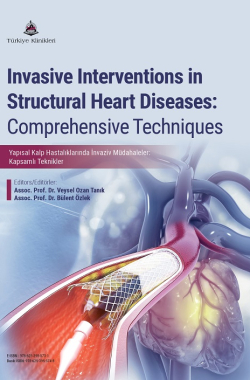PATENT DUCTUS ARTERIOSUS (PDA) CLOSURE
Emre Paçacı
Osmanı̇ye State Hospı̇tal, Department of Cardiology, Osmanı̇ye, Türkiye
Paçacı E. Patent Ductus Arteriosus (PDA) Closure. In: Tanık VO, Özlek B, editors. Invasive Interventions in Structural Heart Diseases: Comprehensive Techniques. 1st ed. Ankara: Türkiye Klinikleri; 2025. p.537-544.
ABSTRACT
The ductus artery (DA) is a vascular structure that connects the proximal left pulmonary artery and the descending aorta in fetal life. Its function in fetal life was to deliver deoxygenated blood from the superior vena cava to the descending aorta and to transport it through the placenta to the maternal bloodstream. The DA can have various shapes and characteristics. The most common shape is conical, with the distal aortic end being larger than the pulmonary artery end. The size and shape of the PDA are important for device selection in transcatheter closure procedures. PDA was surgically closed by Gross and Hubbard in 1939 and this was reported as the first case in the literature. Nowadays, with the development of transcatheter treatment methods, surgical treatment is only used in patients with inappropriate anatomy.
Keywords: Patent ductus arteriosus; Heart disease
Kaynak Göster
Referanslar
- Gournay V. The ductus arteriosus: physiology, regulation, and functional and congenital anomalies. Arch Cardiovasc Dis. 2011;104(11):578-585. [Crossref] [PubMed]
- Krueger M, Cronin P, Sayyouh M, Kelly AM. Significant incidental cardiac disease on thoracic CT: what the general radiologist needs to know. Insights Imaging. 2019;10(1):10. [Crossref] [PubMed] [PMC]
- Lloyd TR, Beekman RH 3rd. Clinically silent patent ductus arteriosus. Am Heart J. 1994;127(6):1664-1665. [Crossref] [PubMed]
- Nora JJ. Multifactorial inheritance hypothesis for the etiology of congenital heart diseases. The genetic-environmental interaction. Circulation. 1968;38(3):604-617. [Crossref] [PubMed]
- Backes CH, Hill KD, Shelton EL, et al. Patent Ductus Arteriosus: A Contemporary Perspective for the Pediatric and Adult Cardiac Care Provider. J Am Heart Assoc. 2022;11(17):e025784. [Crossref] [PubMed] [PMC]
- Rajesh V, Kheiwa A, Varadarajan P. Echocardiography in adult patients with PDA: A simplified approach. Echocardiography. 2020;37(12):2194-2198. [Crossref] [PubMed]
- Lee SJ, Yoo SM, Son MJ, White CS. The patent ductus arteriosus in adults with special focus on role of ct. Diagnostics [Internet]. 2021 [cited 2025 Jan 31];11(12). Available from: [Crossref] [PubMed] [PMC]
- Schneider DJ. The patent ductus arteriosus in term infants, children, and adults. Semin Perinatol. 2012;36(2):146-153. [Crossref] [PubMed]
- Marelli A, Beauchesne L, Colman J, et al. Canadian Cardiovascular Society 2022 Guidelines for Cardiovascular Interventions in Adults With Congenital Heart Disease. Can J Cardiol. 2022;38(7):862-896. [Crossref] [PubMed]
- Jeong YH, Yun TJ, Song JM, et al. Left ventricular remodeling and change of systolic function after closure of patent ductus arteriosus in adults: device and surgical closure. Am Heart J. 2007;154(3):436-440. [Crossref] [PubMed]
- Baumgartner H, De Backer J, Babu-Narayan SV, et al. 2020 ESC Guidelines for the management of adult congenital heart disease. Eur Heart J. 2021;42(6):563-645. [PubMed]
- Porstmann W, Wierny L, Warnke H. Closure of persistent ductus arteriosus without thoracotomy. Ger Med Mon. 1967;12(6):259-261. [PubMed]
- Behjati-Ardakani M, Rafiei M, Behjati-Ardakani MA, Vafaeenasab M, Sarebanhassanabadi M. Long-term Results of Transcatheter Closure of Patent Ductus Arteriosus in Adolescents and Adults with Amplatzer Duct Occluder. N Am J Med Sci. 2015;7(5):208-211. [Crossref] [PubMed] [PMC]
- Saliba Z, El-Rassi I, Abi-Warde MT, et al. The Amplatzer Duct Occluder II: a new device for percutaneous ductus arteriosus closure. J Interv Cardiol. 2009;22(6):496-502. [Crossref] [PubMed]
- Cuaso CC, Tan RB, Del Rosario JD, Cheng DD, Reyes KG. Update on the Amplatzer duct occluder: a 10-year experience in Asia. Pediatr Cardiol. 2012;33(4):533-538. [Crossref] [PubMed]
- Hiremath G, Aggarwal V, Soule K, Bass JL. Immediate angiographic residual shunt using the Nit-Occlud device for patent ductus arteriosus closure. Postepy Kardiol Interwencyjnej. 2020;16(4):460-465. [Crossref] [PubMed] [PMC]
- Galeczka M, Szkutnik M, Bialkowski J, et al. Transcatheter Closure of Patent Ductus Arteriosus in Elderly Patients: Initial and One-Year Follow-Up Results-Do We Have the Proper Device?. J Interv Cardiol. 2020;2020:4585124. [Crossref] [PubMed] [PMC]
- Backes CH, Cheatham SL, Deyo GM, et al. Percutaneous Patent Ductus Arteriosus (PDA) Closure in Very Preterm Infants: Feasibility and Complications. J Am Heart Assoc. 2016;5(2):e002923. [Crossref] [PubMed] [PMC]
- Regitz-Zagrosek V, Roos-Hesselink JW, Bauersachs J, et al. 2018 ESC Guidelines for the management of cardiovascular diseases during pregnancy. Eur Heart J. 2018;39(34):3165-3241. [Crossref] [PubMed]
- Yorgun H, Canpolat U, Kaya EB, Aytemir K, Oto A. Thrombus formation during percutaneous closure of an atrial septal defect with an Amplatzer septal occluder. Tex Heart Inst J. 2011;38(4):427-30. [PMC]

